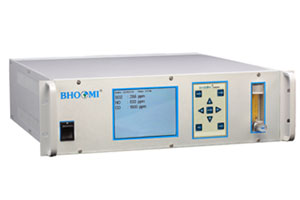The role of CEMS in power plants
Power plants are under increasing scrutiny to reduce their emissions and adhere to stringent regulatory standards. Continuous Emission Monitoring Systems (CEMS) have emerged as a critical tool in helping power plants monitor and manage their emissions effectively. Here, we explore the role of Bhoomi Make BI 7000 CEMS analyser in power plants when it comes to ensuring compliance, optimising operations and protecting the environment.
Ensuring regulatory compliance
- Accurate monitoring: BI 7000 CEMS provide real-time, continuous monitoring of various pollutants emitted by power plants. These include sulphur dioxide (SO2), nitrogen oxides (NOx), carbon dioxide (CO2) and particulate matter. The systems offer precise measurements, ensuring that power plants can accurately track their emissions levels.
- Regulatory requirements: Many countries have established stringent environmental regulations. These regulations might require power plants to continuously monitor and report their emissions. BI 7000 CEMS help power plants comply with these regulations by providing reliable data that can be submitted to regulatory agencies. This ensures that power plants meet legal requirements and avoid potential fines or sanctions.
- Audit trails: BI7000 CEMS generates comprehensive records of emissions data over time. They create an audit trail that can be reviewed during inspections or regulatory audits. This documentation is vital for demonstrating compliance and maintaining transparency with regulatory bodies.
Optimising operational efficiency
- Process optimisation: By providing real-time emissions data, BI 7000 CEMS helps power plant operators to optimise their processes for greater efficiency. For example, operators can adjust combustion parameters to minimise the production of pollutants while maintaining optimal energy output. This not only reduces emissions but also improves the overall efficiency of the power plant.
- Preventive maintenance: Continuous monitoring allows for the early detection of potential issues that could lead to increased emissions or operational inefficiencies. BI7000 CEMS can alert operators to deviations from normal emission levels. Such deviations can indicate possible equipment malfunctions or maintenance needs. Addressing these issues promptly can prevent costly downtime and ensure the plant operates smoothly.
- Energy management: CEMS data can be integrated with other plant management systems to provide a holistic view of the plant’s performance. This integration allows for better energy management, helping plants to reduce energy consumption and lower operational costs.
Protecting the environment
- Emission reduction: One of the primary goals of implementing BI7000 CEMS is to reduce harmful emissions from power plants. By continuously monitoring and managing emissions, power plants can implement strategies to minimise their environmental impact. This contributes to cleaner air and helps mitigate the risks of acid rain, smog and climate change.
- Public health: Reducing emissions of pollutants, such as SO2 and NOx is crucial for protecting public health. These pollutants can cause respiratory problems, cardiovascular diseases and other health issues. By using CEMS to monitor and control emissions, power plants play a vital role in safeguarding the health of nearby communities.
Looking for CEMS gas analysers?
Explore our liquid and gas analysing solutions. We manufacture and supply a variety of CEMS analysers for various industrial applications. We are the only company to have more than one product in this segment. Our CEMS analysers, such as the BI 7000 series, are available with different sensor technologies. For instance, we offer NDUV, TDLS, FTIR, FID and NDIR sensors for the accurate measurement of different gases. Our portable options allow for mobile usage of these analysers. We also have stationary models that are suited for the more traditional applications.




